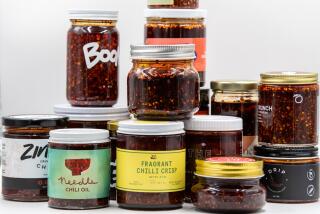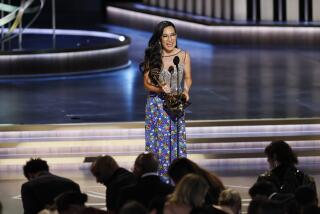Funny or Racist? âMr. Wongâ Draws Mixed Reaction
There always has been a fine line between humor and insult, especially when the subject is race and ethnicity. Enter âMr. Wong,â an animation cartoon series that premiered last month on Icebox.com. Seven vignettes feature escapades of the 85-year-old, buck-toothed, yellow-faced Chinese houseboy serving his white socialite boss, Miss Pam. She is always insulting her servant. When he becomes ill, Miss Pam asks, âWhatâs wrong? You look more yellow than normal.â
Not surprisingly, the cartoonâs creators have received letters from Asian Americans who find the caricature offensive and are demanding that the cartoon be pulled. What is surprising is that many Asian Americans find âMr. Wongâ funny, including three at L.A.-based Icebox. The cartoonâs production coordinator Colleen Murakami and vice president Joel Kuwahara are both Japanese American. Board member Lily Chang is a Chinese American.
The flap over âMr. Wongâ also sheds light on the relationship between race and the Internet--âcyber-race,â a term that UCLA law professor Jerry Kang has coined for how race relations, attitudes and practices are transferred and transformed from the real world to the Web.
âThe Internet has a cocooning phenomena, and it drives everything to the extreme,â he said. âConsidering the reactions to âMr. Wong,â I wouldnât be surprised if in the future there are more extreme racialized forms of humor on the Internet.â
âMr. Wongâ follows in the tradition of the irreverent, sarcastic and trash-talking cartoons such as âSouth Parkâ and âThe Simpsons.â âMr. Wongâsâ creators, Pam Brady and Kyle McCulloch, also write South Park, but they declined to comment.
Kuwahara said âMr. Wongâ was the first show of Iceboxâs cartoon lineup that made him laugh.
âIt was a really funny script,â said the 31-year-old, fourth-generation Japanese American. âYou just canât take it that seriously.â He said that the cartoonâs critics are from an ultra-politically correct crowd and that they need to lighten up. âThis cartoon plays on their sensitivity. Itâs just entertainment.â
When âMr. Wongâ went online, Asianavenue.com, an online Asian American community Web site, decided to survey viewers by linking to the Icebox site. The survey of the 9,125 18- to 24-year-olds found that 20% considered the cartoon âtotally offensiveâ; 33% said âoffensive but laughedâ anyway; 19% said it was an expression of free speech; and 28% found it âfunny as hell.â
âWeâre all about audience, and if even the Asian American audience is so split, we donât plan to pull the show,â said Steve Stanford, co-founder and CEO of the animation company. Stanford, who is African American, hopes to gain enough of an audience for âMr. Wongâ from the Web to propel the cartoon into mainstream television.
Ken Narasaki, literary manager for the East West Players based in Los Angeles, the oldest Asian Pacific American theater group in the United States, is bothered by the cartoonâs mix of humor and ethnicity.
âHow are you supposed to fight this kind of humor? This Internet generation is less sensitive. In a way, people who care about racism are portrayed as dinosaurs,â said Narasaki, a 42-year-old fourth-generation Japanese American.
The mixed views reflect generational divides and differences in experiences. The Asian American population is two-thirds foreign born because the influx of immigrants came after 1965 when immigration laws were liberalized. Unlike those who arrived at the last turn of the century and experienced rampant discrimination and exclusion, the younger generations have had an easier time assimilating--thanks, in part, to the civil rights movement and affirmative action.
For many Asian Americans, especially older ones, âMr. Wongâ is reminiscent of derogatory caricatures of the Yellow Peril and Charlie Chan.
Kang of UCLA said Asian Americans âneed to realize that stereotypes work in subtle ways now. People donât wear bed sheets and don KKK [garb]; itâs not that overt anymore. All these racist events in history create a backdrop of how people perceive Asians.â
Henry Tang, chairman of the Committee of 100, a New York-based nonpartisan organization of prominent Americans of Chinese descent, said most young Asian Americans donât experience subtle racism until age 25, after some encounter it in the working world.
Asian American identity is not generally discussed until college, and even then many colleges donât offer classes on Asian America, according to Edmund Lee, site manager for Asianavenue.com.
Indeed, although people of Asian ancestry have been attending American schools for more than a century, they are yet to be a part of a âcomprehensiveâ social studies and language arts curriculum, Anaheim Union High School teacher Michael Matsuda told the first town hall meeting of President Clintonâs Commission on Asian Americans and Pacific Islanders last week.
Kang likens the marginalizing of Asian Americans to the effect pornography has on how women are treated.
âWe tend to laugh it off a little easier than we ought to, considering how history, culture, stereotypes and humor are all connected. We donât realize how bad the damage is though,â Kang said.
Then there are other media images such as that of Ling, the strong Chinese American character in âAlly McBeal.â Still, some Asian Americans dislike her as a new incarnation of the dragon lady.
As for âMr. Wong,â the cartoon is being shown, but production is on hiatus, which is the case with other Icebox cartoons. Stanford said âMr. Wongâ is being reviewed before new episodes are Web cast this fall.
More to Read
The biggest entertainment stories
Get our big stories about Hollywood, film, television, music, arts, culture and more right in your inbox as soon as they publish.
You may occasionally receive promotional content from the Los Angeles Times.










